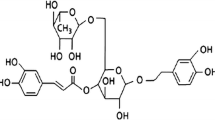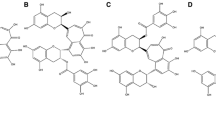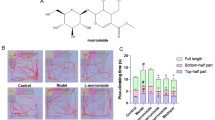Abstract
Glycyrrhizic acid (GA) is the most effective ingredient in the root of licorice, with important pharmacological effects. We investigate the effects of GA on mitochondrial function and biogenesis in the aluminum toxicity in PC12 cell line. After pretreatment of PC12 cells with different concentrations of GA (5–100 μM), and specific concentration of aluminum maltolate (Almal,1000 μM) for 48 h, cell viability, reactive oxygen species (ROS), mitochondrial membrane potential (MMP), mitochondria mass, cytochrome c oxidase enzyme activity, and the ATP level of the cells were measured. The expression mRNA level of PGC-1α, NRF1, NRF2, and TFAM was confirmed by the real-time PCR quantitative method. The results showed that low concentrations of GA protected Almal-induced cell death in 48 h. It was also observed that GA reduced the ROS production and increased the ATP level. The activity of cytochrome c oxidase enzyme and also decrease of MMP were improved. In addition, GA significantly increased the expression of mitochondrial genes and mass against aluminum toxicity. GA can exert its protective effect against the toxicity of Almal through maintaining mitochondrial function and subsequently increasing energy metabolism and mitochondrial biogenesis. GA as a natural product can be considered as a supplement in neurodegenerative disease.




Similar content being viewed by others

References
Akman T, Guven M, Aras AB, Ozkan A, Sen HM, Okuyucu A, Kalkan Y, Sehitoglu I, Silan C, Cosar M (2015) The neuroprotective effect of glycyrrhizic acid on an experimental model of focal cerebral ischemia in rats. Inflammation 38:1581–1588
Arabsolghar R, Saberzadeh J, Khodaei F, Borojeni RA, Khorsand M, Rashedinia M (2017) The protective effect of sodium benzoate on aluminium toxicity in PC12 cell line. Res Pharmaceutical Sci 12:391
Becaria A, Campbell A, Bondy S (2002) Aluminium as a toxicant. Toxicology Industrial Health 18:309–320
Bertholf RL, Herman MM, Savory J, Carpenter RM, Sturgill BC, Katsetos CD, VandenBerg SR, Wills MR (1989) A long-term intravenous model of aluminium maltol toxicity in rabbits: tissue distribution, hepatic, renal, and neuronal cytoskeletal changes associated with systemic exposure. Toxicology Appl Pharmacology 98:58–74
Cantó C, Auwerx J (2009) PGC-1alpha, SIRT1 and AMPK, an energy sensing network that controls energy expenditure. Current Opinion Lipidology 20:98
Dominy JE, Puigserver P (2013) Mitochondrial biogenesis through activation of nuclear signaling proteins. Cold Spring Harbor Perspectives Biology 5:a015008
Fetterman JL, Holbrook M, Westbrook DG, Brown JA, Feeley KP, Bretón-Romero R, Linder EA, Berk BD, Weisbrod RM, Widlansky ME (2016) Mitochondrial DNA damage and vascular function in patients with diabetes mellitus and atherosclerotic cardiovascular disease. Cardiovascular Diabetology 15:53
Golpich M, Amini E, Mohamed Z, Azman Ali R, Mohamed Ibrahim N, Ahmadiani A (2017) Mitochondrial dysfunction and biogenesis in neurodegenerative diseases: pathogenesis and treatment. CNS Neuroscience Therapeutics 23:5–22
Guo C, Sun L, Chen X, Zhang D (2013) Oxidative stress, mitochondrial damage and neurodegenerative diseases. Neural Regeneration Res 8:2003
Guo J, Yang C, Yang J, Yao Y (2016) Glycyrrhizic acid ameliorates cognitive impairment in a rat model of vascular dementia associated with oxidative damage and inhibition of voltage-gated sodium channels CNS & Neurological Disorders-Drug Targets (Formerly Current Drug Targets-CNS & Neurological Disorders) 15:1001–1008.
Haleagrahara N, Varkkey J, Chakravarthi S (2011) Cardioprotective effects of glycyrrhizic acid against isoproterenol-induced myocardial ischemia in rats. International journal of molecular sciences 12:7100–7113
Kao T-C, Shyu M-H, Yen G-C (2008) Neuroprotective effects of glycyrrhizic acid and 18β-glycyrrhetinic acid in PC12 cells via modulation of the PI3K/Akt pathway. J Agricultural Food Chemistry 57:754–761
Kim S-W, Jin Y, Shin J-H, Kim I-D, Lee H-K, Park S, Han P-L, Lee J-K (2012) Glycyrrhizic acid affords robust neuroprotection in the postischemic brain via anti-inflammatory effect by inhibiting HMGB1 phosphorylation and secretion. Neurobiology Disease 46:147–156
Książek-Winiarek D, Głąbiński A (2015) The role of oxidative stress in neurodegenerative diseases. In: Studies on Psychiatric Disorders. Springer, pp 151–167
Kumar V, Bal A, Gill KD (2008) Impairment of mitochondrial energy metabolism in different regions of rat brain following chronic exposure to aluminium. Brain Res 1232:94–103
Kumar V, Gill KD (2009) Aluminium neurotoxicity: neurobehavioural and oxidative aspects. Archives of toxicology 83:965–978
Lagouge M, Argmann C, Gerhart-Hines Z, Meziane H, Lerin C, Daussin F, Messadeq N, Milne J, Lambert P, Elliott P (2006) Resveratrol improves mitochondrial function and protects against metabolic disease by activating SIRT1 and PGC-1α. Cell 127:1109–1122
Lee H, Kim YO, Kim H, Kim SY, Noh HS, Kang SS, Cho GJ, Choi WS, Suk K (2003) Flavonoid wogonin from medicinal herb is neuroprotective by inhibiting inflammatory activation of microglia. FASEB J 17:1943–1944
Leuner K, Hauptmann S, Abdel-Kader R, Scherping I, Keil U, Strosznajder JB, Eckert A, Müller WE (2007) Mitochondrial dysfunction: the first domino in brain aging and Alzheimer’s disease? Antioxidants Redox Signaling 9:1659–1676
Li JY, Cao HY, Liu P, Cheng Gh, Sun My (2014) Glycyrrhizic acid in the treatment of liver diseases: literature review. BioMed Res Int 2014:15. https://doi.org/10.1155/2014/872139
Liu H, Mao P, Wang J, Wang T, Xie C-H (2015) Allicin protects PC12 cells against 6-OHDA-induced oxidative stress and mitochondrial dysfunction via regulating mitochondrial dynamics. Cellular Physiology Biochemistry 36:966–979
Marchi S, Giorgi C, Suski JM, Agnoletto C, Bononi A, Bonora M, De Marchi E, Missiroli S, Patergnani S, Poletti F (2012) Mitochondria-ros crosstalk in the control of cell death and aging. J Signal Transduction 2012
Martin-Cordero C, Jose Leon-Gonzalez A, Manuel Calderon-Montano J, Burgos-Moron E, Lopez-Lazaro M (2012) Pro-oxidant natural products as anticancer agents. Current Drug Targets 13:1006–1028
Niknahad H, Jamshidzadeh A, Heidari R, Zarei M, Ommati MM (2017) Ammonia-induced mitochondrial dysfunction and energy metabolism disturbances in isolated brain and liver mitochondria, and the effect of taurine administration: relevance to hepatic encephalopathy treatment. Clinical Experimental Hepatology 3:141
Quinlan CL, Orr AL, Perevoshchikova IV, Treberg JR, Ackrell BA, Brand MD (2012) Mitochondrial complex II can generate reactive oxygen species at high rates in both the forward and reverse reactions. J Biological Chemistry 287:27255–27,264
Rahal A, Kumar A, Singh V, Yadav B, Tiwari R, Chakraborty S, Dhama K (2014) Oxidative stress, prooxidants, and antioxidants: the interplay BioMed research international 2014.
Rashedinia M, Jamshidzadeh A, Mehrabadi AR, Niknahad H (2016) Prevention of phosphine-induced cytotoxicity by nutrients in HepG2 cells. Indian J Medical Res 144:560
Reeve AK, Krishnan KJ, Turnbull D (2008) Mitochondrial DNA mutations in disease, aging, and neurodegeneration. Annals New York Academy Sci 1147:21–29
Saberzadeh J, Arabsolghar R, Takhshid MA (2016a) Alpha synuclein protein is involved in aluminium-induced cell death and oxidative stress in PC12 cells. Brain Res 1635:153–160
Saberzadeh J, Omrani M, Takhshid MA (2016b) Protective effects of nimodipine and lithium against aluminium-induced cell death and oxidative stress in PC12 cells. Iranian J basic Medical Sci 19:1251
Savory J, Herman MM, Ghribi O (2003) Intracellular mechanisms underlying aluminium-induced apoptosis in rabbit brain. J Inorganic Biochemistry 97:151–154
Sharifzadeh M, Shamsa F, Shiran S, Karimfar MH, Miri AH, Jalalizadeh H, Gholizadeh S, Salar F, Tabrizian K (2008) A time course analysis of systemic administration of aqueous licorice extract on spatial memory retention in rats. Planta Medica 74:485–490
Sharma DR, Sunkaria A, Wani WY, Sharma RK, Kandimalla RJ, Bal A, Gill KD (2013) Aluminium induced oxidative stress results in decreased mitochondrial biogenesis via modulation of PGC-1α expression. Toxicology Appl Pharmacology 273:365–380
Sharma DR, Sunkaria A, Wani WY, Sharma RK, Verma D, Priyanka K, Bal A, Gill KD (2015) Quercetin protects against aluminium induced oxidative stress and promotes mitochondrial biogenesis via activation of the PGC-1α signaling pathway. Neurotoxicology 51:116–137
Song J-H, Lee J-W, Shim B, Lee C-Y, Choi S, Kang C, Sohn N-W, Shin J-W (2013) Glycyrrhizin alleviates neuroinflammation and memory deficit induced by systemic lipopolysaccharide treatment in mice. Molecules 18:15788–15,803
Song MY, Jung HW, Kang SY, Park Y-K (2017) Atractylenolide III enhances energy metabolism by increasing the SIRT-1 and PGC1α expression with AMPK phosphorylation in C2C12 mouse skeletal muscle cells. Biological Pharmaceutical Bulletin 40:339–344
Spinazzi M, Casarin A, Pertegato V, Salviati L, Angelini C (2012) Assessment of mitochondrial respiratory chain enzymatic activities on tissues and cultured cells. Nature Protocols 7:1235–1246
Sun Q, Wang F, Li W, Li W, Hu Y-c, Li S, Zhu J-h, Zhou M, C-h H (2013) Glycyrrhizic acid confers neuroprotection after subarachnoid hemorrhage via inhibition of high mobility group box-1 protein: a hypothesis for novel therapy of subarachnoid hemorrhage. Medical Hypotheses 81:681–685
Takeyama N, Matsuo N, Tanaka T (1993) Oxidative damage to mitochondria is mediated by the Ca2+-dependent inner-membrane permeability transition. Biochemical J 294:719–725
Teixeira J, Chavarria D, Borges F, Wojtczak L, Wieckowsk M, Karkucińska-Wieckowska A, Oliveira P (2017) Dietary polyphenols and mitochondrial function: role in health and disease current medicinal chemistry.
Torrens-Mas M, González-Hedström D, Abrisqueta M, Roca P, Oliver J, Sastre-Serra J (2017) PGC-1α in melanoma: a key factor for antioxidant response and mitochondrial function. J Cellular Biochemistry.
Twig G, Shirihai OS (2011) The interplay between mitochondrial dynamics and mitophagy. Antioxidants Redox Signaling 14:1939–1951
Valerio A, Bertolotti P, Delbarba A, Perego C, Dossena M, Ragni M, Spano P, Carruba MO, De Simoni MG, Nisoli E (2011) Glycogen synthase kinase-3 inhibition reduces ischemic cerebral damage, restores impaired mitochondrial biogenesis and prevents ROS production. J Neurochemistry 116:1148–1159
Valero-Grinan TM (2014) Mitochondrial biogenesis: pharmacological approaches.
Westerink R, Ewing A (2008) The PC12 cell as model for neurosecretion. Acta Physiologica 192:273–285
Yang M, Yu L, Gupta R (2004) Analysis of changes in energy and redox states in HepG2 hepatoma and C6 glioma cells upon exposure to cadmium. Toxicology 201:105–113
Yans A, Shahamati SZ, Maghsoudi AH, Maghsoudi N (2015) Digitoflavone provokes mitochondrial biogenesis in PC12 cells: a protective approach to oxidative stress. Pharmaceutical Biology 53:1727–1734
Zorov DB, Juhaszova M, Sollott SJ (2014) Mitochondrial reactive oxygen species (ROS) and ROS-induced ROS release. Physiological Rev 94:909–950
Acknowledgments
In this project, the instrumental facilities provided by Diagnostic Laboratory Sciences and Technology Research Center of Shiraz University of Medical Sciences is greatly acknowledged.
The authors wish to thank Mr. H. Argasi at the Research Consultation Center (RCC) of Shiraz University of Medical Sciences for his invaluable assistance in editing this manuscript. This article extracted from the thesis written by Tannaz Khosravi Bakhtiari and Solmaz Hozhabri.
Funding
This investigation was financially supported by the Vice Chancellor of Research Affairs of Shiraz University of Medical Sciences (Grant No.95-01-36-13362).
Author information
Authors and Affiliations
Corresponding author
Ethics declarations
Competing Interest
The authors declare that they have no conflict of interest.
Rights and permissions
About this article
Cite this article
Rashedinia, M., Saberzadeh, J., Khosravi Bakhtiari, T. et al. Glycyrrhizic Acid Ameliorates Mitochondrial Function and Biogenesis Against Aluminum Toxicity in PC12 Cells. Neurotox Res 35, 584–593 (2019). https://doi.org/10.1007/s12640-018-9967-2
Received:
Revised:
Accepted:
Published:
Issue Date:
DOI: https://doi.org/10.1007/s12640-018-9967-2



